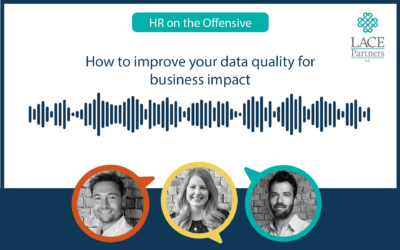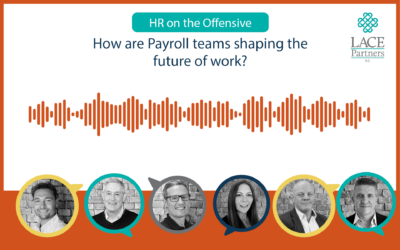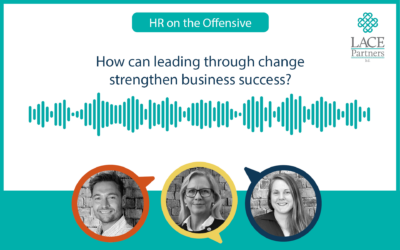LACE was recently asked to give our view on the digitalisation of HR and what HR teams need to successfully deliver a digital HR transformation in The HR Director magazine. The latest edition can be downloaded here. In today’s blog we’ve summarised some of the key points from the article.
The missing element in successful digital transformation
Across our profession it seems we’re on the cusp of becoming people-focused digital organisations, if only one of the four essential elements wasn’t so much in deficit.
Three elements are often in abundance – vision, tech and budget. HR Directors, for example, of some of the biggest companies in the UK have formulated their transformation vision. They can see that gaining a single integrated view of each employee globally or enabling talent mobility or improving diversity is essential – and within reach. The Cloud is helping empower them. There is less reliance on IT departments, systems are faster to implement, and versions are updated regularly meaning users get new evergreen functionality without the pain of traditional upgrades.
There are prolific amounts of new HR tech solutions to choose from. In fact, according to Human Resource Executive, global HR technology has never had so much investment, reaching over $17billion in 2021, meaning tech solutions have never been more exciting. According to the article’s author, George LaRocque, this is down to pent-up demand and low interest rates creating a lot of money ‘looking for a place to go’, as well as COVID-19 and societal issues demanding new HR capabilities.
And then there’s budget. Organisations are often willing to pay for change – full transformation or upgrades. The C-Suite understands many key issues need solving – perhaps improving hybrid working, communication, performance or wellbeing – likely because they’re experiencing the fall out.
The fourth element, where organisations unsurprisingly unite in falling down time and time again, is data.
New tech won’t fix data and process issues
It is tempting to think shiny new tech will fix data and process issues, but it will not. Long before technology is purchased or a system integrator steps in, it’s fundamental that an organisation gets its house in order so that it can achieve the capabilities that new Cloud tech can deliver.
Getting data and processes in the best place possible not only minimises the expense of new tech implementation, but it also maximises transformation potential. From our experience, organisations that don’t prepare will go through a painful implementation. Worse, they later discover they have the same problems they had with the previous system, they’ve spent the budget and they cannot deliver promised results.
Getting this right isn’t straightforward, but it is within reach. Organisations can get to meaningful reporting and analytics, based on consistent processes and data, so they can quickly provide insights for talent, capability gaps, cost and resource efficiencies.
Good data is essential to digital transformation
A building is a good analogy for HR technology, with the people inside it being the data. It’s possible to have the best building in the world, but without people populating it, it’s a lifeless shell.
A building also needs structure – hallways and rooms, wiring and pipes. In this analogy, these are the processes that people use to do their work, and the more these are standardised, where everyone uses the right room, in the right way, the more harmonious it becomes.
For a Cloud transformation to work well, organisations need to agree a set of processes, albeit with permissible variations to local needs. These processes can vary tremendously, and it’s perhaps comforting to know that it’s an issue that hasn’t changed significantly over the past 10-15 years. For instance, firms have long had the problem of reducing thousands of job definitions globally to a more reasonable number of standardised jobs. It’s the same situation for salary scales, the definition of full-time equivalent (FTE), and any number of other HR dimensions and processes.
So how do you get this into shape? The first step is to have a clearly defined people data architecture. Start with the data that’s available today and where it’s right. This is a ‘data residency and ownership matrix’. With this, it’s possible to look clearly at how future functionality can be structured, so that it’s possible to start putting in place the logical building blocks and data dependencies.
Funding and costs
Although there isn’t a lack of funding for new technology in many businesses, HR can often grapple with two core issues when it comes to progressing visions – the ‘do nothing’ problem and the fact that HR is a support service, so isn’t at the top of the pile for extra budget.
Since every business is different, and there is no standard route to become Cloud ready, the importance of creating a clearly defined strategy, business case and conceptual design is undeniable. These will show how proposed investment will support people, business operations and anticipated growth plans. It’s important to understand the full proposed costs, as well as how the system will reduce operating costs. On top of this, define how organisational benefits will be measured. Current systems and contracts also need to be reviewed to consider exit clauses.
Building a step-by-step plan brings clarity of process to understand efficiencies that can be gained. For HRD’s, not only will this ease immediate struggles, but it will also help avoid pitfalls, rework and costs later.
It’s true that Cloud transformation is less expensive than implementing previous on-premise technology, but it still comes at a price. To provide a rough idea, if an on-premise technology change costs 100 units, a Cloud-driven transformation for the same scope is likely to cost about 60-70 units.
There’s also a potential to save costs by updating existing systems, and many organisations are doing this, but this isn’t a route to gain wholesale transformation. Be clear whether current technology is fit for purpose and whether enhancing a current platform can work for the organisational needs.
Technology complexities less, change management complexities more
Bear in mind too, that Cloud transformations can be just as complicated as on-premise transformations, but in different ways. The technology complexity may be less, but the change management complexity is more.
To explain, on-premise systems can be adapted within reason to what an organisation needs, which means an organisation doesn’t necessarily need to change as much. Cloud platforms, on the other hand, do have flexibility, but within certain parameters, meaning more organisational change is likely. Cloud comes with the mantra of Adopt not Adapt. Use the system as delivered rather than trying to customise It.
New systems also require adoption and behaviour change from users, so guiding people to use them efficiently is part and parcel of the activity. An advantage with Cloud systems is that they tend to have a significantly improved user experience. What’s more, it’s easier to automate and streamline HR activities in Cloud based systems, providing a relatively lower investment for the benefits.
Creating a transformative experience for an organisation using Cloud systems is not necessarily resource intensive, but the quantitative nature of it means it can take time. Hurdles will arise; having a sense of humour on your cloud transformation journey is best practice. When the implementation has taken place, however, the insights available can drive consistency and informed decision-making for the business – supporting the house and all its occupants.
If you’d like to talk find out about how we can help you with your digital transformation journey, take a look at our I need to digitise my workforce, delivering value and insights section of our website.
To talk to us about your digital transformation journey, contact us here.






